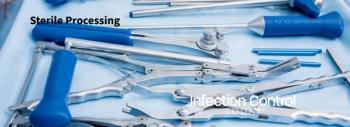
Addressing Fast Turnovers of Surgical Instrumentation
Turning surgical instrumentation over quickly for the operating room (OR) has always been, and may remain, a constant hot topic. It is a critical issue for several reasons. Flashing is not a viable option for non-emergencies. Capital funds for inventory are not as robust as in years past. Sterile processing departments are often not located within or adjacent to many OR suites at most facilities. Surgical instrumentation and other medical devices are more complex and require unique and extensive processing more then ever. Furthermore, organisms are just as complex as the instruments we are trying to process, so, room for error is much less.
By Michele D. DeMeo
Turning surgical instrumentation over quickly for the operating room (OR) has always been, and may remain, a constant hot topic. It is a critical issue for several reasons. Flashing is not a viable option for non-emergencies. Capital funds for inventory are not as robust as in years past. Sterile processing departments are often not located within or adjacent to many OR suites at most facilities. Surgical instrumentation and other medical devices are more complex and require unique and extensive processing more then ever. Furthermore, organisms are just as complex as the instruments we are trying to process, so, room for error is much less.
There are numerous reasons why "flashing" is not appropriate. Abbreviated cycles are meant for emergency purposes only. I am often asked why this is, since "sterilization is sterilization." My response to this statement is usually, "But it is the fact that the item is needed quickly that places the process of turning it over as fast as possible in jeopardy. The actual cycle is less the issue then both the pre- and post-steps in the process." The meaning of my response is lost to my intended audience at times. It is challenging to convey the imperative requirements of every single step in the sterilization process to someone who just wants the item "now."
Let us talk about those pre- and post-steps that are required in the actual sterilization cycle and how they impact the end result of the process for the instrumentation's sterility. Since both of these phases affect the outcome of sterility, they both must be consistently followed in a manner that maintains proper technique. This means all instruments are cleaned in a manner specified by the manufacturer. That is very hard to do when racing in between cases, at a sink that does not have the normal processing provisions, and without a copy of the instructions. It means that the item will be quickly cleaned with or without a brush, with whatever soap is available and may or may not be rinsed adequately, at best. During the cycle, the item likely will not be in a closed container. Post-cycle, the item must then be transported to the room and to the back table within the surgical suite without being contaminated. Think about this -- an open container, moving through different areas, having whatever is in the air flowing over it.
The bottom line is that without attention and using proper technique, we run the risk for process failure. If there is process failure, the item risks remaining unsuitable for reuse. Yet, poor results in the decontamination and sterilization process may go undetected by the sterile processing professional. This is where the issue of flashing comes into place. The OR team will be unaware if the item has been compromised and subsequently, it will be used on a patient during the surgical case.
In order to address and improve the quality of "fast turnovers" we need to address why there is a need for flashing. This is an important question to answer if reducing flashing is a goal, all while still providing fast turnovers with instrumentation. While there are several reasons for it, let us discuss just one for now for the purposes of this article. A lack of available funds for capital expenditures for many facilities is a reality. It simply is not the norm to have enough money available to purchase sufficient instrumentation to never need to turn a set of instruments over quickly again. First, operational norms change, so the amount and types of surgical baskets and devices would constantly be changing and acquisitions would never be on target. Secondly, even if money was available for use by most facilities, is that really the best use for it? Maybe not. We are left with organizing the funds we do have in just the right ways for current needs, with an eye for future expectations. This also means orchestrating what and how we use the funds we do have a bit differently then in previous years. Furthermore, it requires orchestrating the tasks and processes we conduct differently, too.
Unless you are in the middle of a brand-new department build-out or facility replacement process, we cannot often change where the sterile processing department (SPD) is located. While the SPDs function in many hospitals has drastically changed over the years to primarily focus on processing instrumentation, its location was better suited for its previous role of supply distribution -- centrally located to disperse goods to all end users. Our end users are shrinking and our main customer in the majority of healthcare facilities is the surgical department. This means looking at how and when we interact with our main customer and re-evaluating our effectiveness from time to time. It means questioning if we "round" to the OR often enough. Whether or not we have the most current daily surgical schedule, we can make adjustments to our daily activities. This is done with the goal to help prevent another flash cycle. It means challenging whether or not your SPDs hours of operation are in line with your largest customer's hours and needs. It means questioning everything to find the most relevant model to follow for operational functioning -- especially since you often are not right next door to the OR.
Fast turnovers are hampered by the design of devices and instruments. They are not simple scissors and needle holders anymore. With new surgical compliments such as robots, instruments are finely designed and have very specific and detailed processing necessities that must be adhered to strictly. These steps cannot be omitted or even shortened. This means that planning is even more critical then ever. For example, if you only have one set of robotic instruments, how can you have two back-to-back cases booked through scheduling? Preventing this occurrence requires planning, communication and developing proper operational processes and tools. It means uniting the SPD with new services that are brought into a facility, so these details can be organized and planned proactively.
Just as instruments are more complex, so are the organisms we are trying to eradicate from the instruments and devices. It is not an option to pick and choose what steps in the sterile processing function will be done over others. For surgical instruments and other patient-care devices and equipment to be safe for reuse, care must be taken to ensure every required step in not only taken, but done in the manner specifically prescribed by the manufacturer. There cannot be short-cuts with this. Bugs will survive if the items are not cleaned properly. Contaminates may infect a susceptible patient if the item is transferred incorrectly. Furthermore, patients are not as healthy as in the past. Yes, we have wonderful drugs and interventions, but as a society, we have more chronic diseases that compromise health and promote infections. This cannot be ignored.
Where does this lead us? Here are a few pointers that might help to guide your instrumentation processing to achieve the right instrument at the right time, without needing so many fast turnovers:
-- Bring the SPD department into OR operational discussions and planning. Conversely, OR members should be a part of the planning for SPD. Those figurative "walls" must be removed, otherwise, strategic planning will not be as fruitful as needed nor as possible. SPD must know what surgical case volume projections are anticipated for the coming year. They must know that physician recruitment planning is occurring. These are just a few bits of data that is needed to plan for proper instrumentation.
-- A review of current SPD operational practices against surgical department norms should be considered. If surgeries are ending at 9 p.m. on average but your SPD is only staffed until 11 p.m., you will have unmet surgical instrument needs for the next business day, resulting in more fast turnover requests.
-- Consider including the SPD in morning reports in the OR. This will give the SPD members a sense of the day ahead, differently than just the paper surgical schedule. It also will help to create a team atmosphere between the two units.
-- Review booking practices. Question your "resource conflict" mechanisms.
-- Review and consider coordinating your purchases as a team. The more input between each unit, the wiser your purchasing decisions will be, especially since money is hard to come by for many facilities.
Fast turnovers will remain a topic for discussion for as long surgeries still take place. However, the more often that the SPD and the OR can build independent operational systems that parallel each other, the less of a critical issue fast turnovers will be. Marrying functions that will honor the obvious interdependencies will result in quality instrumentation exactly when your patients need it.
Michele D. DeMeo is sterile processing manager for Memorial Hospital in York Pa. as well as principal of MDD Consulting.
Newsletter
Stay prepared and protected with Infection Control Today's newsletter, delivering essential updates, best practices, and expert insights for infection preventionists.





